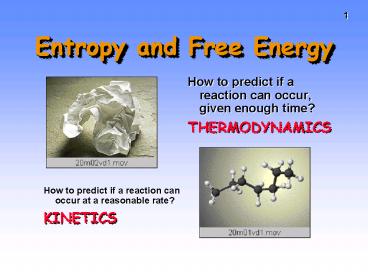Entropy and Free Energy - PowerPoint PPT Presentation
1 / 27
Title:
Entropy and Free Energy
Description:
Entropy and Free Energy. How to predict if a reaction can occur, given enough time? ... One property common to spontaneous processes is that the final state is more ... – PowerPoint PPT presentation
Number of Views:20
Avg rating:3.0/5.0
Title: Entropy and Free Energy
1
Entropy and Free Energy
- How to predict if a reaction can occur, given
enough time? - THERMODYNAMICS
How to predict if a reaction can occur at a
reasonable rate? KINETICS
2
Thermodynamics
- If the state of a chemical system is such that a
rearrangement of its atoms and molecules would
decrease the energy of the system--- - AND the K is greater than 1,
- then this is a product-favored system.
- Most product-favored reactions are
exothermicbut this is not the only criterion
3
Thermodynamics
- Both product- and reactant-favored reactions can
proceed to equilibrium in a spontaneous process. - AgCl(s) e Ag(aq) Cl(aq) K 1.8 x
10-10 - Reaction is not product-favored, but it moves
spontaneously toward equilibrium. - Spontaneous does not imply anything about time
for reaction to occur.
4
Thermodynamics and Kinetics
- Diamond is thermodynamically favored to convert
to graphite, but not kinetically favored.
Paper burns a product-favored reaction. Also
kinetically favored once reaction is begun.
5
Spontaneous Reactions
- In general, spontaneous reactions are exothermic.
- Fe2O3(s) 2 Al(s) ---gt 2 Fe(s) Al2O3(s)
- ?H - 848 kJ
6
Spontaneous Reactions
- But many spontaneous reactions or processes are
endothermic or even have ?H 0.
NH4NO3(s) heat ---gt NH4NO3(aq)
7
Entropy, S
- One property common to spontaneous processes is
that the final state is more DISORDERED or RANDOM
than the original. - Spontaneity is related to an increase in
randomness. - The thermodynamic property related to randomness
is ENTROPY, S.
Reaction of K with water
8
- The entropy of liquid water is greater than the
entropy of solid water (ice) at 0 C.
9
Directionality of Reactions
- How probable is it that reactant molecules will
react? - PROBABILITY suggests that a spontaneous reaction
will result in the dispersal - of energy
- or of matter
- or of energy matter.
10
Directionality of Reactions
- Probability suggests that a spontaneous reaction
will result in the dispersal of energy or of
matter or both. - Matter Dispersal
11
Directionality of Reactions
- Probability suggests that a spontaneous reaction
will result in the dispersal of energy or of
matter or both. - Energy Dispersal
12
Directionality of ReactionsEnergy Dispersal
- Exothermic reactions involve a release of stored
chemical potential energy to the surroundings. - The stored potential energy starts out in a few
molecules but is finally dispersed over a great
many molecules. - The final statewith energy dispersedis more
probable and makes a reaction spontaneous.
13
Entropy, S
So (J/Kmol) H2O(liq) 69.95 H2O(gas) 188.8
- S (gases) gt S (liquids) gt S (solids)
14
Entropy and States of Matter
S(Br2 liq) lt S(Br2 gas)
S(H2O sol) lt S(H2O liq)
15
Entropy, S
- Entropy of a substance increases with temperature.
Molecular motions of heptane at different temps.
Molecular motions of heptane, C7H16
16
Entropy, S
- Increase in molecular complexity generally leads
to increase in S.
17
Entropy, S
- Entropies of ionic solids depend on coulombic
attractions.
So (J/Kmol) MgO 26.9 NaF 51.5
Mg2 O2-
Na F-
18
Entropy, S
- Entropy usually increases when a pure liquid or
solid dissolves in a solvent.
19
Standard Molar Entropies
20
Entropy Changes for Phase Changes
- For a phase change, ?S q/T
- where q heat transferred in phase change
- For H2O (liq) ---gt H2O(g)
- ?H q 40,700 J/mol
21
Entropy and Temperature
22
Calculating ?S for a Reaction
?So ? So (products) - ? So (reactants)
- Consider 2 H2(g) O2(g) ---gt 2 H2O(liq)
- ?So 2 So (H2O) - 2 So (H2) So (O2)
- ?So 2 mol (69.9 J/Kmol) - 2 mol (130.7
J/Kmol) 1 mol (205.3 J/Kmol) - ?So -326.9 J/K
- Note that there is a decrease in S because 3 mol
of gas give 2 mol of liquid.
23
2nd Law of Thermodynamics
- A reaction is spontaneous if ?S for the universe
is positive. - ?Suniverse ?Ssystem ?Ssurroundings
- ?Suniverse gt 0 for spontaneous process
- First calc. entropy created by matter dispersal
(?Ssystem) - Next, calc. entropy created by energy dispersal
(?Ssurround)
24
- Dissolving NH4NO3 in wateran entropy driven
process.
?Suniverse ?Ssystem ?Ssurroundings
25
- 2 H2(g) O2(g) ---gt 2 H2O(liq)
- ?Sosystem -326.9 J/K
Can calc. that ?Horxn ?Hosystem -571.7 kJ
?Sosurroundings 1917 J/K
26
- 2 H2(g) O2(g) ---gt 2 H2O(liq)
- ?Sosystem -326.9 J/K
- ?Sosurroundings 1917 J/K
- ?Souniverse 1590. J/K
- The entropy of the universe is increasing, so the
reaction is product-favored.
27
Spontaneous or Not?
Remember that ?Hsys is proportional to
?Ssurr An exothermic process has ?Ssurr gt 0.































